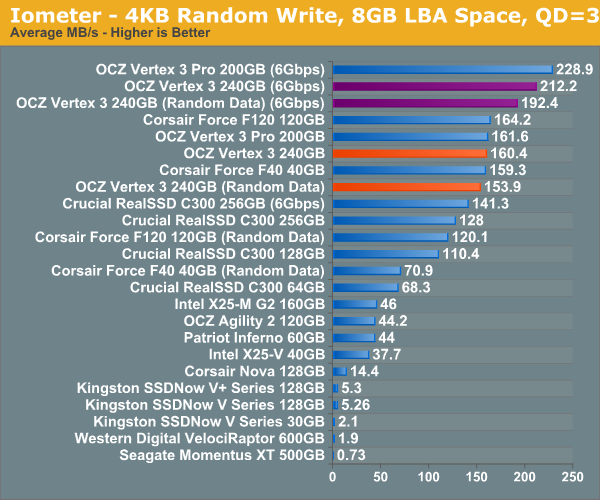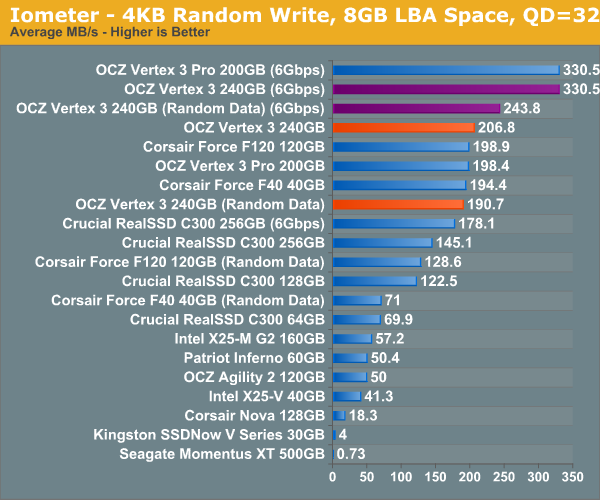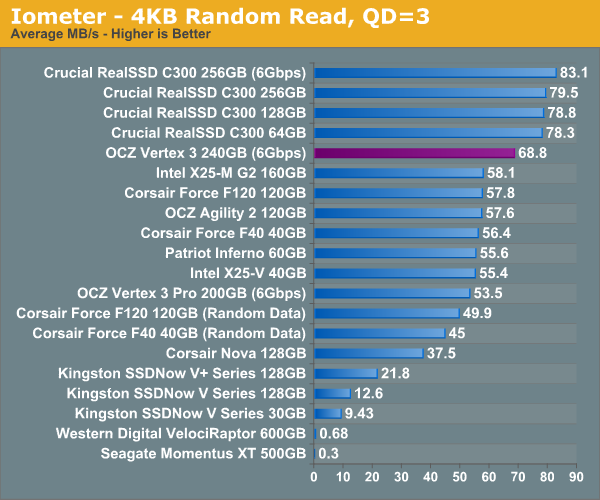OCZ Vertex 3 Preview: Faster and Cheaper than the Vertex 3 Pro
by Anand Lal Shimpi on February 24, 2011 9:02 AM ESTRandom Read/Write Speed
The four corners of SSD performance are as follows: random read, random write, sequential read and sequential write speed. Random accesses are generally small in size, while sequential accesses tend to be larger and thus we have the four Iometer tests we use in all of our reviews.
Our first test writes 4KB in a completely random pattern over an 8GB space of the drive to simulate the sort of random access that you'd see on an OS drive (even this is more stressful than a normal desktop user would see). I perform three concurrent IOs and run the test for 3 minutes. The results reported are in average MB/s over the entire time. We use both standard pseudo randomly generated data for each write as well as fully random data to show you both the maximum and minimum performance offered by SandForce based drives in these tests. The average performance of SF drives will likely be somewhere in between the two values for each drive you see in the graphs. For an understanding of why this matters, read our original SandForce article.

Many of you have asked for random write performance at higher queue depths. What I have below is our 4KB random write test performed at a queue depth of 32 instead of 3. While the vast majority of desktop usage models experience queue depths of 0 - 5, higher depths are possible in heavy I/O (and multi-user) workloads:












85 Comments
View All Comments
FunBunny2 - Friday, February 25, 2011 - link
If you're running a really relational database, then random performance is what matters.iwod - Friday, February 25, 2011 - link
Yes, but 99% of Normal World Users dont run Relational DB. And those who ran the DB would properly search for faster Random I/O instead.jimhsu - Friday, February 25, 2011 - link
It ... depends. Real world performance is really complicated:1. You can have any combination of read or writes, sequential or random, going on at once.
2. You have both synchronous IO (this read must be done before that read) and asynchronous IO (this reads all need to be executed, but in whatever order).
3. You have other bottlenecks coming into play - CPU, memory, GPU, ...
All the basic metrics (seq read/write, random read/write) are important. As well as performance with mixed read/write workloads (this is in fact the most difficult aspect to bench). Hard drives have been around for decades, so we have well-established metrics for determining performance. Flash SSDs have been around for less than 10, and in the consumer market, less than 3 years.
iwod - Friday, February 25, 2011 - link
Yes Performance is Complicated. But it doesn't matter in this context. We are trying to find the bottleneck and fastest Storage Hardware within today's Applications. And the Anandtech Bechmarks, is basically just a batch script that execute common task that we do. Time and Average it as Scores.Time and Time again i have asked why some brand controller, labeled as "crap" by most of us, continuously to perform extremely well, and in many cases even better then Sandforce on Anand Real World Benchmarks ( Read Toshiba Controller in Kingston V+ aka Apple's MBA SSD)
Chaser - Friday, February 25, 2011 - link
As SSDs become more common and second/third generations of models are starting to appear graph bars showing numerical values are beginning to got lost in haze. How would a "PC Mark Vantage score" difference of 3 points equate to an improved and noticable user experience? So while pages of "faster, higher" values might look appealing I am more lost now than anything else.For me, I enjoy reading conclusions similar to GPU results and comparisons. Such as, "If you have a Sandforce 1200 drive upgrading to this next generation wouldn't result in much or more of a noticable change on the average desktop enthusiast or gaming computer.
iwod - Friday, February 25, 2011 - link
The difference of 3 Points will be the same. Because it is within Margin or Error.Read up my post about you.
MamiyaOtaru - Friday, February 25, 2011 - link
"prices will continue to fall"been waiting for them to become reasonable for years now, and this gets repeated when they go up?
I'm hoping for great things from memristors
Spazweasel - Monday, February 28, 2011 - link
So here's a question. With these solid state hard drives bursting to near the maximum transfer rate of SATA3 and completely eclipsing spinning media, the Holy Grail is going to be to approach RAMdisk speed.I'd be curious to see how a drive like this compares to, say, a 4gb RAM disk which has been formatted with the same file system. I imagine the RAMdisk driver and operating system will matter a great deal for such a baseline, but if a RAMdisk driver and config can be settled upon, this would make a very interesting comparison.
As far as I can tell, the SATA3 standard, with 6Gb/sec (little B) will saturate at about 525MB/sec (big B). DDR3/1333 will do so at 10667MB/sec. 20 times faster, right? Well... maybe. This is where file system and driver overhead will loom large. RAID will fatten up the pipe, and ultimately PCIE 2.0 16x will peak at 8192MB/sec (big B). Since PCIE 2.0/16x is close to DDR3/1333 in transfer speeds, in theory (that wonderful place where everything works), the aforementioned Holy Grail is at least in sight at the horizon.
So yeah, I'm curious about RAMdisks vs. fast SSDs in RAID. Just as an exercise.
iwod - Tuesday, March 1, 2011 - link
I know this is old, but can you brief us on WHAT THE HELL HAPPEN to Intel SSD Controller?Was it always suppose to be a Marvel Controller + Intel Firmware? Are is there REAL G3 coming soon?
WintersEdge - Wednesday, March 9, 2011 - link
So this is a preview, right? Although it's quite complete like a full review... Nevertheless, you'll do another review when the product actually comes out? Right? Or what? If so, will you add your energy use test, like you've done for SSD reviews in the past? I know it'll be very small but then again, all the differences in performance are also very small to an end user just doing ordinary tasks.Thanks